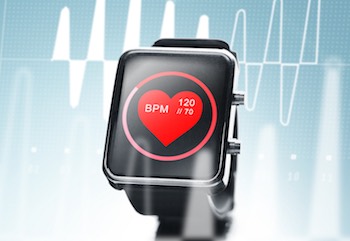 Technology integrated with health tools is a becoming a very popular trend within the healthcare industry and is increasingly being used on a more regular basis. Many of the wearable devices are providing a plethora of health data that can be used to inform both personal and clinical decisions for consumers utilize the growing roster of available tools.
Technology integrated with health tools is a becoming a very popular trend within the healthcare industry and is increasingly being used on a more regular basis. Many of the wearable devices are providing a plethora of health data that can be used to inform both personal and clinical decisions for consumers utilize the growing roster of available tools.
These popular do-dads range from fitness trackers to wearable heart rate monitors. Many are saying these devices will change the way we live and interact with technology from a physical perspective. Additionally, the devices are poised to change the healthcare industry as a whole.
Here are some ways wearables are making their move.
Wearable Devices Make Health Fun
One can’t help but think of fun when technology is being used to track health habits, right? Sure, but it goes a little deeper than that, too.
Many people look at wearable technology as not only a way to monitor their health, but they also look at these wearable devices for style. FitBit and other fitness trackers have taken this fun factor to the next degree, creating devices that are designed to not only bump up your fitness, but that also come in an array of styles so you can choose the one that best fits your personal tastes.
Also, the use of these devices promotes competition among those users who have the devices. For example, if you have a group of friends, you can invite each other to compete on daily steps totals and keep up with one another. This is a great way to hold each other accountable for meeting health goals.
Wearable Devices Are Readily Available
The availability of wearables is integral to their widespread use — and they’re become more common. You can find a number of new varieties on the market, including:
- 9Solutions IPCS is a SaaS and Bluetooth-based application platform and real-time locating system (RTLS) that assists in the safety of healthcare employees and patients.
- AIQ develops smart wearables that can monitor the user’s respiration rate, heart rate and skin temperature.
- The Metria wearable sensor is a skin-friendly adhesive that monitors cardiac performance.
- BodyTel offers at-home diagnostics to monitor blood glucose, blood pressure and weight, and it transmits this information to the doctor’s office.
- PolyPower is a sensor that monitors swelling, posture, motions and breathing.
- Imec’s wearable electroencephalography (EEG) headset and EKG patch monitors your brain and heart information.
- Moticon is an integrated sole sensor that can measure the distribution and motion of patients and athletes.
- Nuubo is a commercially available wireless, remote cardiac monitoring device that uses e-textiles.
- TmG-BMC allows users to monitor muscle fatigue when engaging in physical activity.
- Preventice is a mobile app that can be used to remotely monitor respiration rate, heart rate, ECG and activity level.
These wearables and the wide distribution of devices like these make it easy for patients to engage with technology — and it allows technology to contribute toward health improvements for its users.
Wearable Devices Improve Patient/Doctor Interaction
There is a shift of adoption of these digital technologies from patients and doctors. More doctors are embracing the technology, which helps to bridge the gap between consumers and clinicians. It provides a change in how patients are monitored as well.
“Digitally enabled care is no longer nice to have, it’s fundamental for delivering high quality care,” Daniel Garrett, Health Information Technology Practice Leader, PwC US says. “Just as the banking and retail sectors today use data and technology to improve efficiency, raise quality, and expand services, healthcare must either do the same or lose patients to their competitors who do so.”
The basis of this transition is the relationship of the patient with the doctor. Digital technology helps to foster this connection in a positive way by doing the following:
- Giving the patient diagnostic information.
- Promoting self-management of chronic diseases.
- Fostering teamwork in caregivers.
- Increasing patient-clinician interaction.
Wearable devices can help with medical procedures, too. Surgeons now use virtual reality to help with surgery. Minimally invasive techniques improve patient outcomes and provider performance. Wearable tech even improves patient access to healthcare — broadening the scope of telemedicine in rural areas and others who need distance care and monitoring.
Wearable Devices Assist With Self-Management
Three-quarters of the U.S. population report owning a technology device used to manage fitness.
The proliferation and use of wearable devices help patients to self-manage any conditions they may have by providing detailed information about key health indicators. This information can then be used to create intervention plans in conjunction with clinicians.
Wearable technology is literally the wave of the health industry future. Many of these devices offer the benefits of remote monitoring, which saves time and allows patients to connect with clinicians.
As clinicians integrate the use of these devices into their practice, the use of the tools will become increasingly prevalent — whether we like it or not.

![[IPWatchdog Logo]](https://ipwatchdog.com/wp-content/themes/IPWatchdog%20-%202023/assets/images/temp/logo-small@2x.png)

![[[Advertisement]]](https://ipwatchdog.com/wp-content/uploads/2018/10/Enhance-1-IPWatchdog-Ad-2499x833-1.png)
![[Advertisement]](https://ipwatchdog.com/wp-content/uploads/2024/03/IP-Copilot-Apr-16-2024-sidebar-700x500-scaled-1.jpeg)
![[Advertisement]](https://ipwatchdog.com/wp-content/uploads/2024/04/Patent-Litigation-Masters-2024-sidebar-early-bird-ends-Apr-21-last-chance-700x500-1.jpg)

![[Advertisement]](https://ipwatchdog.com/wp-content/uploads/2021/12/WEBINAR-336-x-280-px.png)
![[Advertisement]](https://ipwatchdog.com/wp-content/uploads/2021/12/2021-Patent-Practice-on-Demand-recorded-Feb-2021-336-x-280.jpg)
![[Advertisement]](https://ipwatchdog.com/wp-content/uploads/2021/12/Ad-4-The-Invent-Patent-System™.png)







Join the Discussion
One comment so far.
Benny
March 13, 2016 05:10 amJust to straighten the statistics – the statement “Three-quarters of the U.S. population report owning a technology device used to manage fitness” does not refer only to wearables – in fact, the majority of these products are portable monitors and video products.